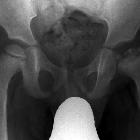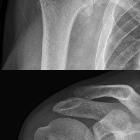idiopathische kindliche Hüftkopfnekrose






































































 nicht verwechseln mit: Perthes lesion of the shoulder
nicht verwechseln mit: Perthes lesion of the shoulderPerthes disease, also known as Legg-Calvé-Perthes disease, refers to idiopathic osteonecrosis of the femoral epiphysis seen in children. It should not be confused with Perthes lesion of the shoulder.
It is a diagnosis of exclusion and other causes of osteonecrosis (including sickle cell disease, leukemia, corticosteroid administration, Gaucher disease) must be ruled out .
Epidemiology
Perthes disease is relatively uncommon and in Western populations has an incidence approaching 5 to 15:100,000.
Boys are five times more likely to be affected than girls. Presentation is typically at a younger age than slipped upper femoral epiphysis (SUFE) with peak presentation at 5-6 years, but confidence intervals are as wide as 2-14 years .
Perthes is considered an idiopathic condition, and there are no clear predisposing factors.
Clinical presentation
Most children present with atraumatic hip pain or limp . Some children have a coincidental history of trauma. This may precipitate the presentation or the realization of symptoms that in fact had been long-standing.
Blood tests are typically normal in Perthes. It is important to be certain that there is no other cause of osteonecrosis (e.g. sickle cell disease) during the workup.
Pathology
The specific cause of osteonecrosis in Perthes disease is unclear.
Osteonecrosis generally occurs secondary to the abnormal or damaged blood supply to the femoral epiphysis, leading to fragmentation, bone loss, and eventual structural collapse of the femoral head. In approximately 15% of cases, osteonecrosis occurs bilaterally.
Radiographic features
The best initial test for the diagnosis of Perthes is a pelvic radiograph. In a small number of patients with Perthes, the radiograph will be normal and persistent symptoms will trigger further imaging, e.g. MRI.
The investigation of atraumatic limp will often include a hip ultrasound to look for effusion, but ultrasound is unlikely to pick up osteonecrosis.
The radiographic findings are those of osteonecrosis. There are separate systems for staging of Perthes disease:
- temporal evolution
- Waldenström classification
- modified Elizabethtown classification
- severity and prognosis
- Catterall classification: extent of femoral head involvement
- Salter-Thompson classification: extent of femoral head involvement
- Herring classification: lateral pillar involvement
- healed stage deformity: osteoarthritis risk
- Stulberg classification
Plain radiograph
The radiographic changes to the femoral epiphyses depend on the severity of osteonecrosis and the amount of time that there has been an alteration of blood supply:
- early: there may be no appreciable change
- established: reduction in epiphysis size, lucency
- late: fragmentation, destruction
As changes progress, the width of the femoral neck increases (coxa magna) in order to increase weight-bearing support.
Early signs
- joint effusion: widening of the medial joint space
- asymmetrical femoral epiphyseal size (smaller on the affected side)
- apparent increased density of the femoral head epiphysis
- blurring of the physeal plate (stage 1)
- radiolucency of the proximal metaphysis
Late signs
Eventually, the femoral head begins to fragment (stage 2), with subchondral lucency (crescent sign) and redistribution of weight-bearing stresses leading to thickening of some trabeculae which become more prominent.
The typical findings of advanced burnt out (stage 4) Perthes disease are:
- femoral head deformity with widening and flattening (coxa plana)
- proximal femoral neck deformity: coxa magna
- "sagging rope sign" (thin sclerotic line running across the femoral neck)
Additionally, tongues of cartilage sometimes extend inferolaterally into the femoral neck, creating lucencies, which must be distinguished from infection or neoplastic lesions . The presence of metaphyseal involvement not only increases the likelihood of femoral neck deformity but also makes early physeal closure with resulting leg length disparity more likely.
Arthrography
Traditionally arthrography performed under general anesthesia with conventional fluoroscopy is performed to assess congruence between the femoral head and the acetabulum in a variety of positions . MRI is increasingly replacing this, in an effort to eliminate pelvic irradiation.
MRI
MRI is gaining an increasing role in a number of scenarios:
- early diagnosis, before the onset of x-ray findings
- assessing the extent of cartilaginous involvement, important in prognosis
- assessing joint congruence in a variety of joint positions (requires open magnet and dynamic imaging)
Both arthrography and dynamic MRI assess three main features :
- deformity of the femoral head (also assessed on static x-rays and MRI)
- congruence: how well the femoral head contour matches that of the acetabulum
- containment: the amount of lateral subluxation of the flattened femoral head out of the acetabulum
- when severe this may lead to hinge abduction, whereby rather than rotation and medial movement of the femoral head during hip abduction, the flattened head 'hinges' on the lateral lip of the acetabulum, widening the medial joint space
Treatment and prognosis
Treatment in Perthes disease is largely related to symptom control, particularly in the early phase of the disease. As the disease progresses, fragmentation and destruction of the femoral head occur. In this situation, operative management is sometimes required to either ensure appropriate coverage of the femoral head by the acetabulum or to replace the femoral head in adult life.
The younger the age at the time of presentation, the more benign disease course is expected, and also for the same age, the prognosis is better in boys than girls due to less maturity . Conservative treatment is favorable in children with a skeletal age of 6 years or less at time of disease onset .
Prognosis is also influenced by the percentage of femoral head involvement and degree of primary deformity of the femoral head and the secondary osteoarthritic changes that ensue. Children with over 50% of femoral head necrosis at time of diagnosis should be considered for operative management . The aim of therapy is to try and maintain good femoroacetabular contact and a round femoral head.
Bracing may be used in milder cases, although femoral neck and acetabular osteotomies may be required to correct more severe abnormal femoroacetabular malalignment.
In later life, hip replacements may be necessary .
History and etymology
The condition was first described in 1897 by Maydl, with Legg, Calvé, and Perthes popularizing it in 1910 in separate publications:
- Karel Maydl (1853-1903): Austrian surgeon
- Arthur Thornton Legg (1874-1939): American orthopedic surgeon
- Jacques Calvé (1875-1954): French orthopedic surgeon
- Georg Clemens Perthes (1869-1927): German surgeon
Differential diagnosis
General imaging differential considerations include:
- slipped superior femoral epiphysis (SUFE)
- osteomyelitis
- secondary causes of osteonecrosis
- dysplasia epiphysealis capitis femoris (Meyer dysplasia)
- usually no epiphyseal condensation, fragmentation, subchondral fractures or collapse
- tumors
- hemophilia
- juvenile rheumatoid arthritis (JRA)
See also
- Waldenström classification of Perthes disease
- modified Elizabethtown classification of Perthes disease
- Catterall classification of Perthes disease
- Salter-Thompson classification of Perthes disease
- Herring classification of Perthes disease

 Assoziationen und Differentialdiagnosen zu idiopathische kindliche Hüftkopfnekrose:
Assoziationen und Differentialdiagnosen zu idiopathische kindliche Hüftkopfnekrose:










